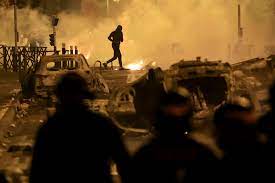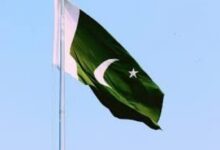France’s Violent Outbreak Reveals Decades Of Social Issues Controlling The Suburbs
The French Revolution introduced the ideas of liberty, equality, and fraternity as well as the first taste of liberal democracy, in which the right to personal freedom is sacred. Free speech and secularism may sometimes cost a lot of money. This was shown by the Prophet Mohammed caricatures published by Charlie Hebdo, which resulted in the deaths of 12 of the magazine’s top editors and cartoonists. Violence is ingrained in culture and sometimes spirals out of hand. France had more violent riots than other countries in West Europe. President Emmanuel Macron had to deal with the Yellow Vest movement of 2019 that was brought on by the increase in fuel prices, the March 2023 pension protests, and now the violence brought on by the police shooting and killing 17-year-old French citizen Nahel Merzouk, who was of Algerian descent, at a traffic light.
I sometimes question if violent upheavals in France lack any type of legitimacy. Perhaps it is acknowledged that a strong reaction to wrong is a natural characteristic of its people. Look at the history of the nation: there have been as many revolutions as counter-revolutions in 1789, 1830, 1848, and 1871. According to Vijay Singh, a writer, director, and journalist who resides in Paris, “they all appear to be a part of a natural historical response.”
Riots often occur in the impoverished and working-class areas of French cities. Nahel was an only kid who resided in Nanterre, a suburb of Paris. He was using the bus-only lane as he was driving. He drove past a red light out of fear when the cops stopped him, but he subsequently became stuck in traffic. When the cops came up to him, one of the officers pulled the gun and killed the boy. At first, the police claimed that the young guy was attempting to drive the car into the two cops, as is customary for law enforcement to protect themselves. Nothing was discovered during the search of his automobile for illicit substances or weapons. But shortly later, a video of the event surfaced, exposing the deception.
As was to be expected, rage broke out in the streets and spread across France’s towns and cities. According to accounts, the majority of the rioters are young, between the ages of 14 and 18. Justice Minister Eric Dupont-Moretti said that 30% of the more than 1,000 rioters detained by the police were under the age of 18. 2,000 automobiles were set on fire by mobs, who also broke windows at restaurants and bank branches while robbing stores and supermarkets. As police attempted to contain the throng, reports of street battles were spread across major cities. Also hurt were over 200 police officers. Police in Marseille said that they had detained 60 persons after making 80 arrests on Friday. According to Reuters, armoured personnel carriers and a helicopter were sent to Lyon, the third-largest city in France, to quell the unrest.
Social media, according to President Emmanuel Macron, has a “considerable role” to play in the propagation of rage and violence.
Governments in nations like India, however, should be aware that in spite of this, the internet has not been shut down to put an end to the riots. The name and home location of the policeman who shot Nahel were posted on social media, according to sources from Paris. The police have asked Twitter, TikTok, Snapchat, and Meta to report any information that incites violence.
Once again, the riots demonstrated how the French government and society had failed to integrate individuals from its former colonies. Since the 16th century, France has been a significant colonial power, much like other European nations. It ruled over significant portions of land in both Africa and Asia. Algeria was linked with France and a part of that nation.
French authority ended in 1962 when Algeria recovered its independence after a bloody conflict that resulted in hundreds of thousands of deaths, mostly on the Algerian side. The French performance in Algiers is incredibly bloated. The colonizers, like other White Christian countries at the time, notably Britain, thought of themselves as “a civilizing force” and denigrated native beliefs and customs. Despite the fact that many of these antiquated ideas are no longer valid, racism still exists, as well as a propensity to denigrate immigrants of color. Not among everyone, but in certain circles, particularly among many police officers who link them to crime, narcotics, and small-time robberies. They have substantially greater unemployment rates than the rest of the nation. Many members of the French law enforcement are wary of Black people, much as many US police officers are. A survey found that Black or Arab young males are 20 times more likely to be stopped by police than White youths on the streets of French cities.
Vijay Singh, however, thinks it is a too simple an explanation. In addition to not being an all-White force, a large portion of the French police force is made up of individuals whose ancestors were originally migrants from North Africa. This raises the complex issue of state allegiance. However, there is a feeling of prejudice in this area since they are also poor and have a raging fury that may quickly become violent.
“These are not immigrants of the first generation. These third-generation children, who speak French and attend French-language schools, are descendants of immigrants who came in the 1950s and 1960s. The majority of residents in these suburban shantytowns are low-income, and their housing is dilapidated. There is a great deal of hostility against the government. They have greater unemployment rates than the general population. The murder of Nahel served as the spark that was needed to enlighten the enraged young minds, according to Bruno Philip, Asia Editor of the prominent French daily Le Monde and a former reporter for the country.
“The government has made significant improvements to these inner communities during the last few of years. Each year, one billion euros are invested to renovate the ghettos with new office buildings and improved housing. But the rate of development is too slow. There is still a lot to accomplish. Both parties are at blame. A segment of French society, the police, and the sons and grandchildren of previous immigrants all exhibit bigotry against those who are faithful to either their nation of origin or their religion, which is Islam.
The emergence of Islamic extremist organizations over the last 20 years has made this worse. Since 9/11, Islamophobia has been pervasive across Europe and the rest of the globe due to the emergence of Islamic radicals and significant terrorist attacks in Europe. This hostility against French citizens of foreign descent contributes to the rising popularity of Marine Le Pen’s far-right party. Macron will struggle to overcome the nationalist Le Pen in the presidential race. Each riot in France increases support for the extreme right.
At the time of writing, the level of violence has significantly decreased, but who will make sure it doesn’t happen again? One solution is development. There is little prospect, as sociologist Francois Dubet notes in an interview with Le Monde, without a powerful social movement to focus the ire and discontent of the populace in the correct direction.”The riots in the suburbs are a societal issue, but they do not result in the creation of an actor; as a result, it is not unexpected that they repeat themselves in a fairly consistent manner. This political void is not only an issue for the suburbs: the “yellow vests”‘ fury, which differs greatly from that of urban youth, has not been able to take on a political shape. Again, after a time, everything seemed to come down to altercations with the police since the leaders had no “real interlocutors” because all the spokespersons were in conflict, according to Dubet.







